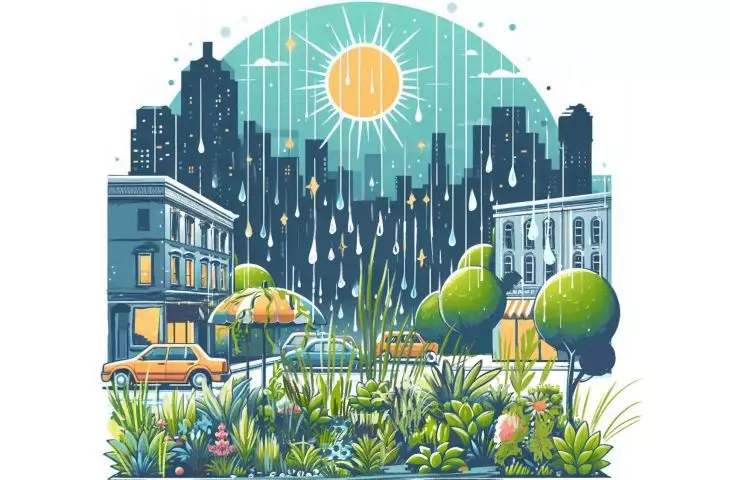Rain gardens are becoming an increasingly popular solution in urban landscapes. Today's cities are facing problems of rainwater management and pollution. Rain gardens are an ideal answer to these challenges, combining aesthetic functions with ecological and safety features.
what are rain gardens?
A rain garden is a specially designed area designed to capture, filter and store rainwater before it simply runs off into the sewer system. They are counted among the elements of the city's green and blue infrastructure. These are plantings of plants in the ground with increased permeability, which collect rainwater from an area much larger than the area of the garden itself. Typically, it is a depression in the ground, filled with a special filtering medium and hydrophytic plants, resistant to periodic flooding. Thanks to rain gardens, less water flows from impermeable surfaces (sidewalks, streets, parking lots, squares) into the sewer system, which contributes to water retention. This prevents lowering of groundwater levels and local flooding during heavy rainfall.
how do rain gardens work?
Rain gardens are used to manage rainwater, promoting small-scale retention by reducing surface runoff. They are extremely effective not only in parks or gardens, but also next to blocks of flats, office buildings, near wide streets, bypasses. The operation of rain gardens is based on retaining and slowly passing rainwater into the soil. With the right design, which includes permeable layers and properly selected vegetation, rainwater can effectively soak into the ground. Studies show that rain gardens have about 30% higher water soaking efficiency compared to a typical lawn[1]. Another advantage of rain gardens is their ability to purify water. Rainwater that enters a rain garden passes through filtration layers, including a vegetation layer that absorbs pollutants. As a result, rain gardens can remove up to 90% of the pollutants contained in rainwater[2].
construction of rain gardens
Rain gardens are constructed depending on their location. They often consist of several layers: surface, permeable and drainage. Sometimes we can still find an anti-erosion layer on top, consisting of stones or gravel. The surface layer is the vegetation layer, and it is in this layer that plants grow. The permeable layer consists of sand and fine gravel, which allows water to slowly seep into the deeper layers of the soil. The drainage layer, at the very bottom of the rain garden, provides drainage of excess water.
The processes in rain gardens include water capture, filtration, infiltration, and storage and evaporation. Rainwater flows from the surface of roofs, sidewalks and streets into the rain garden. It then passes through layers of vegetation, soil, sand and gravel, where it is filtered of contaminants such as heavy metals, oils and chemicals. The purified water is gradually absorbed by the soil, feeding groundwater. Some of the water can be retained in the garden and then evaporated by plants.
Depending on the design - the garden can both infiltrate water and be an airtight solution designed for retention. In both cases, runoff is minimized through evapotranspiration (evaporation). The volume of the rain garden must take into account the rate of so-called local design rainfall. During heavy rainfall, emergency overflows divert water into a small retention system, a storm drain or a special absorption well[3].
How to design a rain garden?
Designing a rain garden requires consideration of several key aspects. First of all, the garden should be located in an area where it can effectively capture rainwater, such as near catchment areas from roofs, near parking lots or other paved surfaces. It is important that the soil has sufficient permeability to allow water infiltration. If necessary, additional supporting layers can be used. The selection of plants should include species resistant to periodic flooding, which grow well in the local climate and soil conditions. In our climatic conditions, rain gardens are the realm of sedges, foxgloves, purple oystercatcher or forget-me-nots, as well as serpentine knotweed or perennial ferns, such as royal fern[4]. You can also use perennials - for example, marsh marsh marigold, forget-me-not or bird's foot sedge, or slightly taller plants, meadow primrose, orange tongue, water-mint or cal amus will be useful here.
Like any garden, a rain garden requires regular maintenance, such as removing weeds, monitoring the condition of the plants and ensuring the proper functioning of the drainage system.
advantages of rain gardens
Rain gardens are very good at reducing the risk of flooding. By slowing the flow of rainwater, they reduce the risk of flooding and overloading sewer systems. In addition, the natural filtration processes in rain gardens effectively remove pollutants from rainwater, improving surface and groundwater quality. They also create habitats for a variety of plant and animal species, supporting local biodiversity. In addition, plants in rain gardens absorb carbon dioxide, produce oxygen and increase atmospheric humidity, which has a positive effect on the microclimate of urban areas. Rain gardens are also attractive landscape features, and can serve as places for recreation and environmental education.
Rain gardens in Poland
In Poland, rain gardens are becoming increasingly popular, especially in cities that are looking for ways to sustainably manage rainwater. One example is Wroclaw[5], where projects integrating rain gardens into urban space are underway. Similar initiatives can also be found in Warsaw[6], Poznan[7], Krakow[8], or in Gorzow Wielkopolski[9], Gdansk[10] and Gdynia - the city won the main prize in the Innovative Local Government competition for the Gdynia Rain Garden project in recognition of an innovative initiative to encourage the residents of Gdynia for so-called small rainwater retention and education on the role and importance of rainwater in the urban environment[11].
Rain gardens are an ecological solution that helps manage rainwater, improve the quality of the urban environment and increase biodiversity. As climate change and urbanization become more challenging, rain gardens can play a key role in building a good place to live.
Magdalena Milert
[1] https://klimada2.ios.gov.pl/pokaz-ogrody-deszczowe/
[2] https://sendzimir.org.pl/projekty/projekt-climate-nbs-polska/
[3] https://sztuka-krajobrazu.pl/4293/artykul/jak-zbudowac-ogrod-deszczowy
[4] https://hadart.pl/pl/ogrody-deszczowe-wspaniala-koncepcja-dla-zrownowazenia-terenow-miejskich/
[5] https://www.wroclaw.pl/zielony-wroclaw/ogrody-deszczowe-niecki-rozszczelnienia-wroclaw-lapie-deszcz-stawia-na-zielen
[6] https://zdm.waw.pl/aktualnosci/zielone-ulice-coraz-wiecej-ogrodow-deszczowych/
[7] https://www.poznan.pl/mim/info/news/ogrody-deszczowe,162254.html
[8] https:// w ww.krakow.pl/aktualnosci/255910,26,komunikat,ogrody_deszczowe_coraz_popularniejsze_w_krakowie.html?_ga=2.43002597.1746388925.1640590062-278236564.1637146203
[9] https://aerisfuturo.pl/portfolio/ogrody-deszczowe-w-gorzowie-wielkopolskim/
[10] https://www.gdansk.pl/siedlce/ogrody-deszczowe-w-gdansku-zobacz-jak-powstawal-czwarty-z-nich,a,129611
[11] https://klimada2.ios.gov.pl/ogrod-deszczowy/gdynskie-ogrody-deszczowe/














